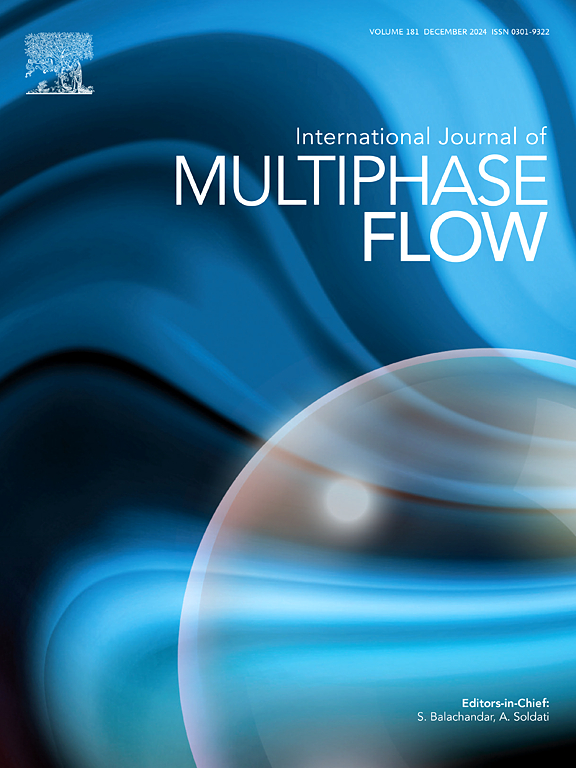The effect of collisions on the explosive dispersal of particles
IF 3.6
2区 工程技术
Q1 MECHANICS
International Journal of Multiphase Flow
Pub Date : 2025-04-24
DOI:10.1016/j.ijmultiphaseflow.2025.105261
引用次数: 0
Abstract
The explosive dispersal of particles produces distinct clusters or jets of particles within the expanding flow. The mechanism that precipitates this behavior is still not fully understood. Experimental data at the particle level can be difficult to obtain, as experiments often involve explosive testing. Simulations may offer additional insight into how the jetting phenomenon develops. A series of 2D simulations are performed in order to investigate the phenomenon at the mesoscale, with fully resolved particle–particle and particle–gas interactions. Particles are modeled as fully resolved cylinders via a volume penalization method. Phase interactions are captured by two-way particle–gas coupling and particle–particle collisions and momentum transfer. Two particle cloud geometries are considered in order to isolate possible sources of jetting: planar shock and compression waves impacting a rectangular particle cloud and an annular cloud about a cylindrically expanding blast wave. In each case, particle distribution within the cloud is varied with forced initial perturbations in area fraction in order to investigate the effects of spatial perturbation on cloud development. Particle positions, velocities, acceleration, and spatial auto-correlation statistics are used to characterize the evolution of the system over time. Jetting is observed to be mainly influenced by particle collisions as opposed to fluid interactions due to the time scale in which fluid structures take to form.

碰撞对粒子爆炸扩散的影响
颗粒的爆炸扩散在膨胀流中产生明显的颗粒团簇或喷流。引发这种行为的机制仍未完全了解。粒子水平的实验数据很难获得,因为实验经常涉及爆炸试验。模拟可以提供更多关于喷射现象如何发展的见解。为了在中尺度上研究这一现象,我们进行了一系列二维模拟,并充分解决了粒子-粒子和粒子-气体的相互作用。通过体积惩罚方法将粒子建模为完全分解的圆柱体。通过双向粒子-气体耦合、粒子-粒子碰撞和动量传递捕获相相互作用。为了分离可能的喷射源,考虑了两种粒子云的几何形状:影响矩形粒子云的平面激波和压缩波以及围绕圆柱形膨胀爆炸波的环形云。在每种情况下,云内的粒子分布随面积分数的强制初始扰动而变化,以便研究空间扰动对云发展的影响。粒子位置、速度、加速度和空间自相关统计用于描述系统随时间的演变。由于流体结构形成的时间尺度,喷射主要受到粒子碰撞的影响,而不是流体相互作用的影响。
本文章由计算机程序翻译,如有差异,请以英文原文为准。
求助全文
约1分钟内获得全文
求助全文
来源期刊
CiteScore
7.30
自引率
10.50%
发文量
244
审稿时长
4 months
期刊介绍:
The International Journal of Multiphase Flow publishes analytical, numerical and experimental articles of lasting interest. The scope of the journal includes all aspects of mass, momentum and energy exchange phenomena among different phases such as occur in disperse flows, gas–liquid and liquid–liquid flows, flows in porous media, boiling, granular flows and others.
The journal publishes full papers, brief communications and conference announcements.

 求助内容:
求助内容: 应助结果提醒方式:
应助结果提醒方式:


